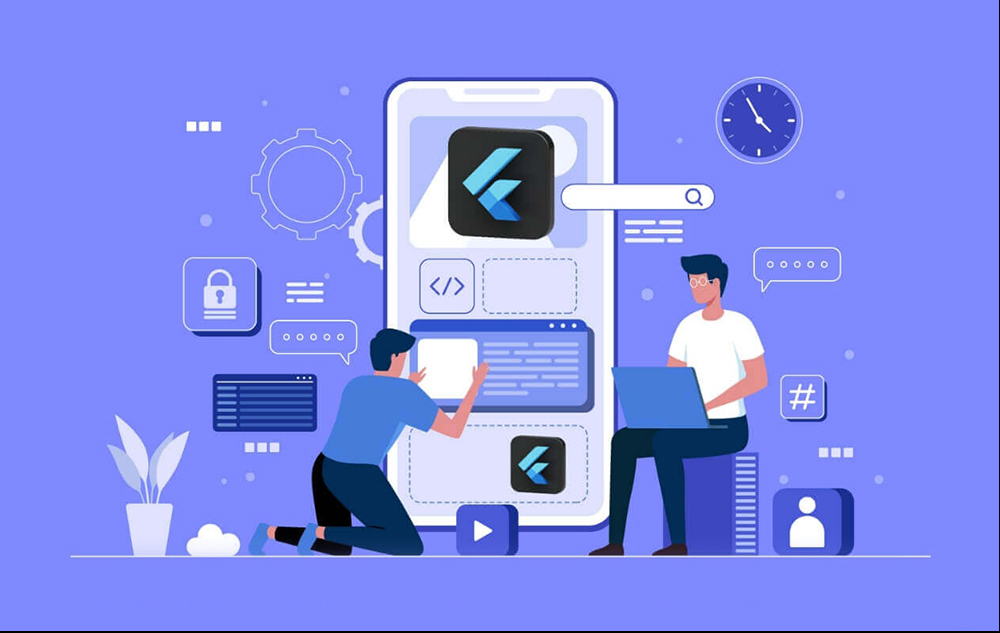Flutter apps development
Revolutionizing User Experience: Trends in Flutter App Development for 2024
- Written by
Monika - Posted on
October 5, 2024

Flutter, Google’s UI toolkit for building natively compiled applications for mobile, web, and desktop from a single codebase, has become a staple in app development. As we look ahead to 2024, several trends in Flutter apps development company in Noida are set to redefine user experience (UX). In a world where digital touchpoints are growing exponentially, the need to offer intuitive, engaging, and personalized user experiences is more critical than ever. Flutter, with its fast-growing ecosystem, provides developers with tools to deliver top-tier user experiences while addressing emerging trends in app design and functionality.
This article explores the top Flutter development trends for 2024 that focus on revolutionizing user experience.
One of the biggest trends in 2024 is the demand for personalized user experiences. As users spend more time on apps, they expect tailored content and designs that reflect their preferences and behaviors. Flutter’s flexible widget system allows developers to create highly adaptive UIs, easily adjusting to different user segments.
Adaptive UI in Flutter can adjust dynamically based on a user’s device type, location, and even in-app behavior. With the support of technologies like AI and machine learning, developers can implement personalized interfaces, recommendation engines, and predictive features to improve the user journey. For instance, apps can now detect user behavior patterns and automatically adapt the interface to present the most relevant content.
Key Tools in Flutter:
flutter_localizations package helps build multi-language apps that cater to diverse audiences.inherited_widget and provider allow apps to reactively update UI based on user inputs and preferences, enhancing personalization.Super apps, which combine multiple functionalities into a single application, are growing in popularity worldwide. From chat to e-commerce, payments, and entertainment, users increasingly expect unified experiences. In 2024, Flutter developers are focusing on building scalable super-app platforms that offer multiple services under one umbrella.
Flutter’s modular approach to development makes it an ideal choice for building super apps. With Flutter’s ability to integrate easily with various backend services and APIs, developers can rapidly build and maintain feature-rich super-app experiences. In addition, Flutter’s cross-platform capabilities ensure that these apps can deliver a consistent experience across mobile, web, and desktop environments.
Examples of Super-App Features in Flutter:
AI and machine learning are increasingly shaping the future of UX, making experiences more personalized and efficient. Flutter’s growing support for AI and ML integration is one of the most significant trends for 2024. Developers can embed smart features like voice recognition, image processing, natural language processing, and real-time data analytics directly into their apps.
Flutter makes this integration smoother with packages like tflite_flutter for TensorFlow Lite and firebase_ml_vision for Firebase’s machine learning vision APIs. For example, using AI models, apps can provide users with real-time visual translations, personalized product recommendations, or advanced voice assistant functionalities.
Examples of AI-Powered UX Improvements:
As attention spans shorten and users demand faster interactions, micro-animations and fluid transitions are gaining traction. These animations not only make the user interface more visually appealing but also enhance usability by providing feedback on user actions.
In 2024, Flutter apps will continue to incorporate more advanced micro-interactions that respond instantly to user input, improving engagement and satisfaction. Flutter’s animation and motion packages provide rich capabilities for building seamless animations. Developers are focusing on creating a natural flow within apps, ensuring that transitions are smooth, informative, and aesthetically pleasing.
Key Animation Techniques:
lottie package for smooth vector animations.Accessibility is no longer a “nice-to-have” feature—it’s becoming a core requirement for app development, especially with legal requirements in many countries enforcing digital accessibility standards. In 2024, Flutter apps will increasingly focus on improving accessibility for users with disabilities.
Flutter’s built-in accessibility support allows developers to create apps that are usable by everyone, regardless of their physical abilities. Features such as screen readers, adaptable text sizes, color contrast adjustments, and gesture-based navigation will become more prominent in Flutter app development.
Flutter supports these through:
As Flutter and its programming language Dart continue to evolve, developers are gaining access to new tools that allow them to build better apps faster. In 2024, Flutter developers will leverage the latest improvements in Flutter 3.x and Dart 3 to accelerate their workflows and enhance performance.
With Dart’s null safety feature now fully integrated, developers can reduce the chances of runtime errors, making their codebases more robust. Performance optimizations in Flutter 3.x, such as the new Impeller rendering engine, will allow for smoother graphics rendering, enabling richer visual experiences with fewer resources.
Key Updates in Flutter 3.x and Dart 3:
In 2024, Progressive Web Apps (PWAs) are set to gain further momentum, and Flutter is one of the leading frameworks making this possible. PWAs combine the best of web and mobile app experiences, offering users fast load times, offline access, and the ability to install the app directly from a browser.
Flutter’s ability to compile to web means that developers can build PWAs from the same codebase as their mobile and desktop apps. With tools like flutter_service_worker and enhanced web rendering capabilities, building responsive, high-performance PWAs in Flutter has never been easier.
Cloud integration and real-time data synchronization are essential components of many modern apps, especially in sectors like e-commerce, healthcare, and social networking. Flutter’s compatibility with Firebase, AWS, and other cloud platforms enables developers to integrate real-time features like push notifications, messaging, and cloud storage seamlessly into their apps.
Real-time data has become a crucial factor for enhancing user engagement, as users expect up-to-date information at all times. Whether it’s real-time chat, live video streaming, or collaborative editing, Flutter’s cloud integration ensures that apps can deliver these experiences reliably.
Real-Time Cloud Services in Flutter:
2024 promises to be an exciting year for Flutter apps development company in Noida, with user experience at the forefront of these innovations. The increasing focus on personalization, AI integration, super-app models, accessibility, and real-time capabilities ensures that Flutter remains the go-to framework for developers looking to create immersive, cross-platform applications. By leveraging these trends, Flutter developers can stay ahead of the curve and deliver truly revolutionary user experiences.
As Flutter continues to evolve and mature, it’s poised to remain a dominant force in shaping the future of mobile app development. Whether you’re a developer or a business looking to launch your next app, keeping these trends in mind will help you stay competitive and delight users with state-of-the-art experiences.
Take your business to new heights by offering unmatched mobility to your customers!


Privacy Policy I Terms & Conditions
© Algosoft Apps Technologies (P) Ltd. (CIN) U93030UP2015PTC075117
Share this article